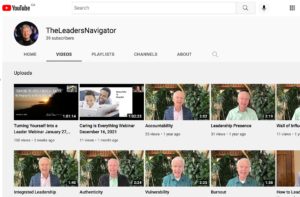Organizational Culture: How To Turn Value Statements In Values
We’ve all seen the nice laminated value statements that hang on office walls. Many of these beautiful calligraphed statements are developed by a well-meaning executive team at an offsite retreat – usually somewhere in the mountains where they can be close to divine inspiration. They bring back the inspired document as if it were the “Ten Commandments,” and “roll them out,” with a well formulated communication strategy. Once they have been communicated and posted on the walls, then everyone goes back to work and the statements are forgotten.
Does this process sound familiar in your organization? No wonder cynicism is abundant about this process. We write the statements. We put them on the wall. Raise expectations. And nothing else happens. What we have is a nice set of value statements. What we don’t have yet is a set of real values.
There is an alternative. In my next few blogs, I will give you a process for turning value statements into real values.
- Build a cohesive executive team. A high trust, aligned, cohesive organizational culture starts with a high trust, aligned, cohesive executive team. In his book, The Advantage: Why Organizational Health Trumps Everything Else In Business, Patrick Lencioni observes, “It’s like a family. If the parents’ relationship is dysfunctional, the family will be too.” We start working with culture by taking the executives away for two days to build trust, clarify their vision and strategy, and define the culture required to realize the vision and strategy.
- Develop an executive team code of conduct. Once the executive has pristine clarity about the kind of culture required they develop a code of conduct for what they expect of each other and how they will, as an executive group, hold each other accountable for living the values. They then develop a plan for how they will stand united as an executive team and make a promise to the organization how it can count on them to live the values and be held accountable for living the values.
- Turn values into behaviors. As the executive team models the way, the expectation is that every positional leader will have the same conversation with every one of their direct reports. To move the organizational value statements off the wall and into the hearts and actions of every employee, every employee must be engaged in a conversation with their manager:
- What exactly do these values mean to me and to you in your specific role?
- What behaviors will demonstrate our values?
- What do we expect from each other?
- Turn conversations into accountability agreements. To ensure trust in your organizational culture, an accountability agreement must lay within each conversation. It provides clarity about what is expected, what is promised, and what support requirements are necessary. The key here is clarity. Ambiguity breeds mediocrity.
- What is the expectation – and the promise – of every leader to live the espoused values?
- What can you count on from me?
- What can I count on from you?
- What are our support requirements of each other?
- Get people engaged. Research tells us that it isn’t clarity of organizational values that engages people. It’s clarity of personal values. You have to get to people’s hearts before you can ask them for a hand. Accountability without passion is drudgery. Accountability without connection is compliance.
- Find out what matters to people: what do people value at work and away from work?
- Get people living their values in their jobs. Maybe it means shuffling some roles around, discovering and developing their talents or working with people’s strengths. Fit people; don’t fix people.
- Continuous Reinforcement. To keep your values alive and keep people engaged in your culture, you have to have continuous reinforcement.
- Tell the story. Before every staff or leadership meeting, take a five minute “culture moment,” where someone on the team tells a story of how someone else lived the values.
- Focus on success. Shine a light on success. Link success to the values. Give public acknowledgment to people when they live the values.
- Embrace the negative. Welcome people to tell you when you aren’t living the values. No one is going to get this perfect. The issue isn’t perfection or even the illusion of perfection. The issue is – can we have the conversation when there is a perceived lack of alignment with the values? Don’t be afraid of the bad news. One of the indicators of trust is that people feel safe to bring the bad news to you. Then you can work toward the solution together!
- Reinforce the message. If you aren’t sick of talking about the culture and the expectations of each other in the culture, then you haven’t talked about it enough. You have to keep giving the message.
- Again and again and again.
- Keep the values visible. Visibility drives accountability.
- Work these conversations into every one of your systems.
- Hiring will now be based not only on operational competence but also on how they will live the values.
- Assessing leadership competence. You’ll know what kind of leaders you need to build the kind of culture you have defined.
- Promotions will now not happen unless the potential leader demonstrates the values.
- Performance reviews will now have an element of values and expected attitudinal behaviors embedded in them.
A few points to consider:
- Don’t be afraid of this process being perceived as superficial, especially in the beginning. Like learning any new skill or developing a new muscle, expect it to feel unfamiliar and even phony at the beginning. Be honest about this, and keep at it.
- Exercise patience with yourself and with others. Remember: there’s a difference between being willing to live the values vs. not doing it perfectly. If a positional leader is not willing to live the espoused values, they should not be in that position and possibly should not even be employed in the organization. But assuming good will, then be both patient and forthright about approaching those who are perceived as not living the values.
- You don’t have to start this process at the very top with your senior executives. If you run a division, get the executives of that division together and start the process. If you manage a team, start with your team. If you run a not-for-profit board, treat your board as the executive and start building an aligned culture. You can even begin with your family, where the parents are the executive. The principles of this process can work with any group of people who are working together toward a shared vision.


